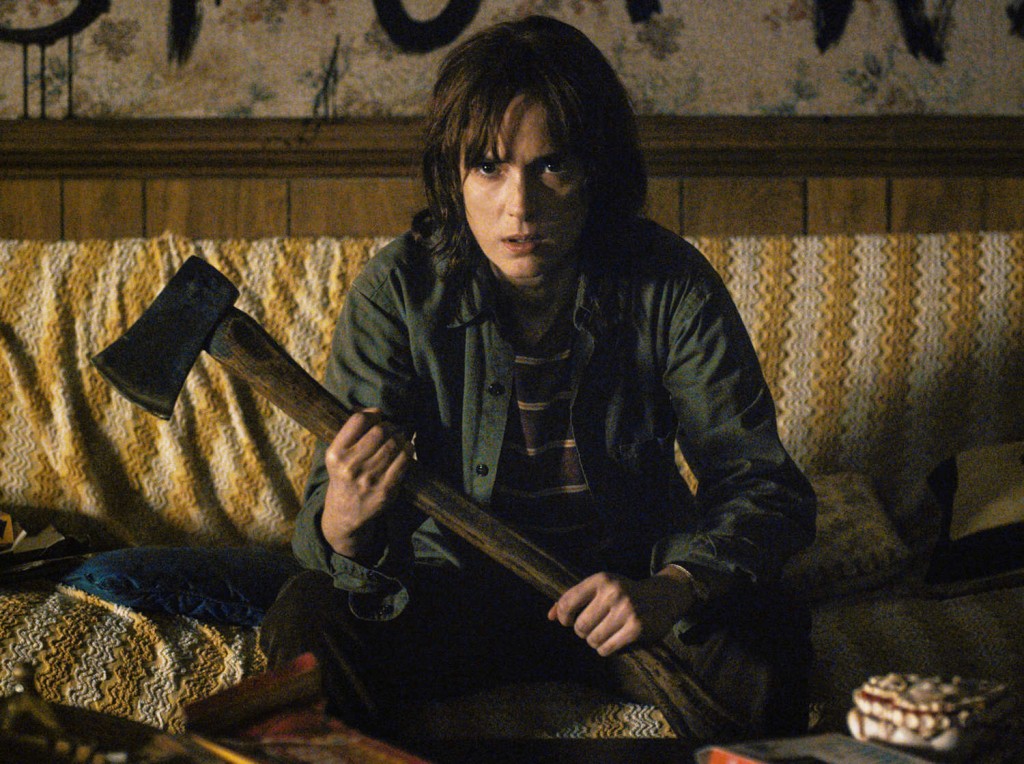The internet is buzzing with praise and discussion of Netflix’s newest original series, Stranger Things. Members of the Deadshirt staff couldn’t help but weigh in on the Duffer Brothers’ homage to King, Spielberg and the ’80s.
It’d be easy to dismiss the Duffer Brothers’ Stranger Things as an ‘80s pastiche: Everything from E.T. to Stephen King’s The Shop to the creature aesthetic of Guillermo Del Toro is silently namechecked on the show. As much as that pool of nostalgic influences is why the show has resonated with so many viewers, the first eight-episode season of Stranger Things really succeeds thanks to a deft ensemble cast. Winona Ryder’s unsteady badass Joyce Byers feels like a natural evolution of the dissatisfied teenager she famously used to play, with her shaking hands as she lights up cigarette after cigarette as she’s ignored or condescended to.
Aside from Ryder and Matthew Modine as a curiously enigmatic government spook, the rest of Stranger Things’ cast is made of virtual unknowns. And maybe because of this, you buy into their characters pretty readily. The Goonies-style trio of Mike, Lucas and Dustin feel like real pre-teens. When you watch David Harbour on screen as town police chief Jim Hopper, it’s remarkable how he plays the disgraced former big city cop’s depression and alcoholism with such a light touch. If the show has a breakout character, it’s Millie Brown’s Eleven. While the townsfolk of Stranger Things are relatable, Eleven’s silence and inscrutability let her steal every scene in the show with just her presence. A little girl robbed of her childhood by uncaring adults, we come to love Eleven. When she sacrifices herself to save her new family, it hurts. A left-field success for Netflix, the kids (and world-weary adults) of Stranger Things are alright.
– Max Robinson
The 1980s kids-on-bikes aesthetic of Stranger Things is done extremely well, and I particularly like the way the footage is aged to make it look like watching a VHS on an old CRT television. The Carpenter-esque score is pitch perfect and the title screen using the EXACT font from the adaptation of King’s Needful Things is an incredible choice. Pop music (mostly from the 1970s) is used frequently throughout the show (although I do admit some tracks were a bit on the nose. “I Melt With You” at a party sequence? We get it. It’s 1983.).
All of this makes Stranger Things enjoyable. But what makes it truly great is the gripping story. The show does a lot. It’s kind of a ghost story, a mystery, and a science fiction tale wrapped up in one package. What’s remarkable is how starkly original it feels. Watching Stranger Things through until the end felt like reading a really good novel. While I wasn’t as satisfied by the ending as most folks, I’m looking forward to the announcement of more episodes. I’m not ready to let go of this world just yet.
– Andrew Niemann
Full disclosure: I am extremely biased in favor of Stranger Things, because it is almost exactly what you would get if you reached into the “stuff I like in horror TV and movies” portion of my brain and assembled it into a cohesive narrative. It’s got kind-hearted nerd kids (portrayed charmingly by Finn Wolfhard, Gaten Matarazzo and Caleb McLaughlin, in descending order of fun to say), each with kind hearts and their own, distinct personalities. It’s got tension, in spades, both of the supernatural and natural-natural varieties. It’s got a spooky pale kid. It’s got freaky monster design that they don’t show you except in brief flashes. And D&D! I love this thing.
But the key word in that first (perhaps too long) sentence is “cohesive.” Stranger Things raises a ton of questions, and it resists the urge to answer them too quickly, if it answers them at all. We learn about Eleven’s (Millie Bobby Brown) background as the characters on screen do, which, yes, provides a mystery to encourage continued viewing, but also helps us better empathize with the characters trying to figure her out. Even – or, I’d argue, especially – Benny (Chris Sullivan), who’s only around for a little bit of two episodes, is someone the viewer feels they know. Moving between the three prongs of the single mystery of Eleven, Dr. Brennan and The Upside-Down (which I’m bundling with Will’s disappearance and communication with his mother) is handled exceptionally well, with strong pacing and even stronger visuals.
What I like about Stranger Things – its sense of restraint, of tension – is perhaps best encapsulated in the scene where Eleven is in the sensory deprivation tank, being instructed to let the monster come to her. The visuals are spare. The fear, of the monster and of disappointing Dr. Brennan, is palpable. That restraint also helps the big moments, like when Joyce Byers’ (Winona Ryder) wall melts away as an extradimensional monster breaks through to terrorize her, feel earned.
All that said, I’m not in love with the closing moments of the season. At the time, it felt like we got Lando’d. Eleven being alive, on its own, could play, but Sheriff Hopper (David Harbour, who turns in solid performances all season as a poorly mending man) knowing it adds a dimension that demands explanation. Seeing as Stranger Things has reportedly been picked up for a second season, perhaps we’ll get it. However, before those closing minutes, I thought this was an excellent closed loop with an entirely acceptable number of open questions. I was ready for Season 2 to take a True Detective-type approach, with a new story and new characters (though, hopefully, without the concomitant dip in quality). In any case, I’m excited to see where Season 2 takes us, in *checks calendar* probably a year, at least. Oh.
– Cameron DeOrdio




